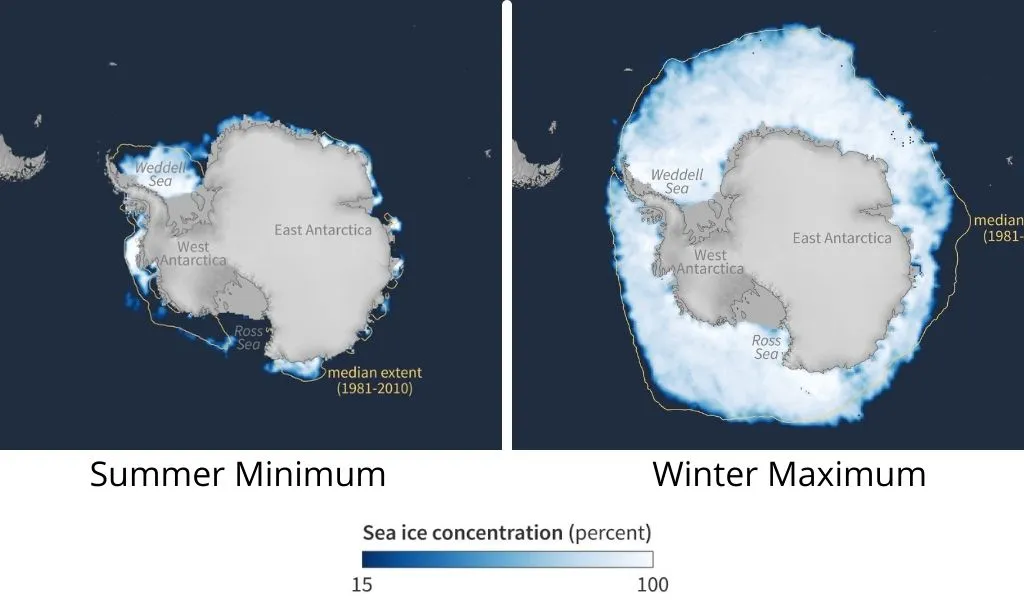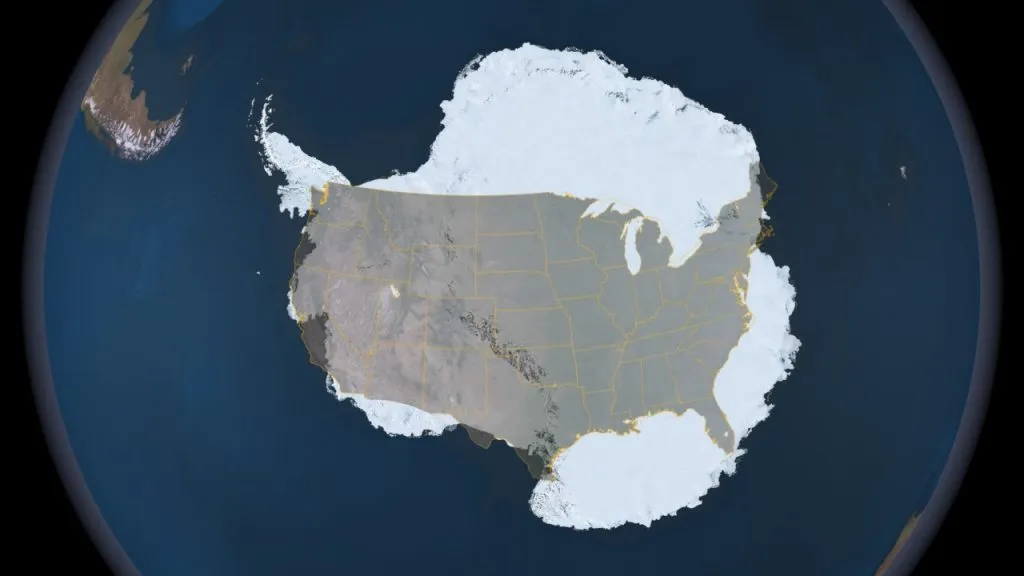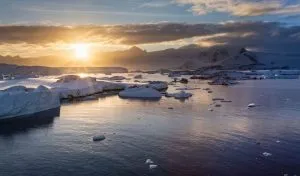Antarctica is the southernmost continent that sits over the south pole. A typical world map doesn’t show Antarctica in full so it can be difficult to visualize its size. So, how big is Antarctica?
Antarctica is 14.2 million km2 making it the 5th largest continent on Earth. It’s covered by the world’s largest ice sheet which is 1,800m thick and weighs 27 million billion tons.
It is surrounded by sea ice which melts in the summer, giving the appearance that it is bigger in winter, however, the continent itself does not change size.
Keep reading for some more facts about the size of Antarctica compared to other countries and to find out what is underneath all that snow and ice.
- How Big is Antarctica?
- How Wide is Antarctica At its Widest Point?
- Is Antarctica Land or Ice?
- What Happens to the Size of Antarctica During Winter?
- Antarctica Winter vs Summer
- Is Antarctica a Continent?
- How Heavy is Antarctica?
- How Big is Antarctica Compared to Other Continents and Countries?
- How Big is Antarctica Compared to the United States?
- How Big is Antarctica Compared to Canada?
- How Big is Antarctica Compared to Russia?
- How Big is Antarctica Compared to Africa?
- How Big is Antarctica Compared to Europe?
- How Big is Antarctica Compared to Australia?
- How Big is Antarctica Compared to the World?
How Big is Antarctica?
Antarctica is 14.2 million km2 (5.5 million sqm), this is larger than Australia and Europe, making it the 5th largest continent on Earth.
Around 98% of the landmass that makes up Antarctica is covered by a giant ice sheet which is the largest single mass of ice found on Earth1 (source: British Antarctic Survey). On average the ice sheet is 1,800 meters (5,900 feet) thick2 (source: Britannica).
The continent is made up of East and West Antarctica which are separated by the Transantarctic Mountain range that lies deep beneath the snow and ice. East Antarctica is the larger of the two and can be found south of Africa and Australia.
West Antarctica includes the Antarctic peninsular which can be seen on a map just below South America. This is the only part of Antarctica that protrudes the Antarctic circle, a line on the map
Antarctica is surrounded by seasonal sea ice which varies between 7.2m sqm at its peak to 1.1m sqm at its low each year, but more on this later.
How Wide is Antarctica At its Widest Point?
At its widest point, Antarctica is 5,339km (3,337 miles) wide, whereas it is 1,234km (771 miles) across its shortest point.
The coastline is a total of 17,968km (11,164 miles) all the way around3 (source: Nations Encyclopedia). It would take about 186 days to walk around the edge of the continent without stopping.
Is Antarctica Land or Ice?
Although only ice and snow is visible in Antarctica, the land underneath the ice sheet is rocky terrain that contains mountains, volcanoes, and valleys.
Antarctica was formed when the supercontinent Gondwana split up, forming modern-day South America, Africa, Australia, India, and Arabia4 (source: Live Science). Antarctica remained connected to Australia until the two split around 33 million years ago, since then Antarctica has drifted south and frozen.
Mapping of the landmass underneath the ice has found that 23% of the ice is formed on land that is below sea level5 (source: British Antarctic Survey).
The melting of this ice has dual consequences for climate change. The most obvious impact is that the ice itself will drain into the ocean. However, a more recent discovery suggests that as the weight of the ice is reduced, the landmass underneath will rise, pushing more water into the ocean6 (source: Rapid postglacial rebound amplifies global sea level rise following West Antarctic Ice Sheet collapse, L. Pan. et al, Science Advances, Vol 7, Issue 18, 2021).
When comparing Antarctica to the Arctic, you’ll find they are very different as the Arctic is mostly ice floating on the ocean with no land underneath.
What Happens to the Size of Antarctica During Winter?
The size of Antarctica appears to change with the different seasons. This is due to the seasonal sea ice that surrounds the continent. The area of the sea ice ranges from 7.2m sqm at its peak in winter to 1.1m sqm at its low in summer.
Antarctica is surrounded by seasonal sea ice which forms on the water. This is in contrast to icebergs, glaciers, ice sheets, and ice shelves which initially form on land.
Antarctic sea ice is at its peak in September, with and covers roughly 7.2 million square miles (18.6 million km2) according to the 1981–2010 average7 (source: National Oceanic and Atmospheric Administration).
As there is no land surrounding Antarctica, the ice is free to float north where it will eventually melt in the warmer water.
Most of the sea ice in Antarctica melts during summer. At its lowest level in February, the remaining sea ice will cover an average of 1.1 million square miles (2.85 million km2) according to the 1981–2010 average.
Antarctica Winter vs Summer
Antarctica is located in the southern hemisphere so the summer months are from October to February and the winter months are March to October.
The below image shows how the sea ice changes the size of the continent between summer and winter. This is based on satellite data provided by National Snow and Ice Data Center from 2021.

Is Antarctica a Continent?
Yes, Antarctica is a continent. The definition of a continent is “a large, continuous, discrete masses of land, ideally separated by expanses of water”8 (source: The Myth of Continents, M. W. Lewis and K Wigen, 1997).
But other characteristics that differentiate a continent from an island include sitting on its own tectonic plate(s), geological distinction (i.e. having different terrain, plants, and animals), and anthropological distinction (i.e. having different people and cultures)9 (source: Britannica).
Antarctica meets all of these criteria which is why it is considered a continent. Underneath the ice and snow is a large, continuous landmass that sits on the Antarctic tectonic plate.
How Heavy is Antarctica?
An interesting Antarctic fact is that the ice in Antarctica weighs about 27 million billion tons (27,000,000,000,000,000 tons)10 (source: Climate Generation). This huge figure is not surprising given that it contains 90% of the world’s ice and 70% of the world’s freshwater11 (source: National Science Foundation).
Scientists estimate that over the 25 years between 1992 and 2017, the continent lost 3 billion tons (3,000,000,000) of ice to the oceans12 (source: Mass balance of the Antarctic Ice Sheet from 1992 to 2017, IMBIE team, Nature, Vol 558, 2018).
The weight is so heavy that it pushes some of the landmass underneath down below sea level. Recent estimates suggest that 23% of the ice in Antarctica is formed on land that is below sea level13 (source: British Antarctic Survey).
This is a problem because the melting ice relieves the downward pressure on the landmass so it may begin to rise as a result, pushing even more water into the ocean as it does so14 (source: Rapid postglacial rebound amplifies global sea level rise following West Antarctic Ice Sheet collapse, L. Pan. et al, Science Advances, Vol 7, Issue 18, 2021).
How Big is Antarctica Compared to Other Continents and Countries?
It can be easier to visualize the size of Antarctica by comparing it to the size of other countries and continents that you are more familiar with:
How Big is Antarctica Compared to the United States?
Antarctica is 14.2 million km2 compared to the 9.834 million km² of the United States. You could fit both the United States and Mexico inside Antarctica. To give a visual comparison, this image shows the United States superimposed on Antarctica:

How Big is Antarctica Compared to Canada?
Canada is 9.985 million km² which is 0.7 times smaller than Antarctica. You could fit both Canada and Greenland inside Antarctica.
How Big is Antarctica Compared to Russia?
Russia is 17.13 million km² which is 1.2 times bigger than Antarctica.
How Big is Antarctica Compared to Africa?
Africa is the 2nd largest continent at 30.37 million km² whereas Antarctica is the 5th largest continent at 14.2 million km2. You could fit Antarctica inside Africa twice.
How Big is Antarctica Compared to Europe?
Europe is the 6th biggest continent at 10.18 million km² whereas Antarctica is the 5th biggest continent at 14.2 million km2. Antarctica is roughly 1.4 times bigger than Europe.
How Big is Antarctica Compared to Australia?
Australia is the smallest continent at 7.692 million km² compared to Antarctica which is the 5th biggest continent at 14.2 million km2. Antarctica is 1.85 times bigger than Australia.
How Big is Antarctica Compared to the World?
The total surface area of Earth is 510.1 million km². Antarctica has an area of 14.2 million km which covers approximately 2.78% of the Earth. There is approximately 30 million km³ of ice in Antarctica which accounts for around 60% of the world’s freshwater15 (source: British Antarctic Survey).



![Read more about the article Arctic vs Antarctica [12 Key Similarities and Differences]](https://polarguidebook.com/wp-content/uploads/2021/07/Arctic-vs-Antarctica-300x176.jpg)
![Read more about the article How Was Antarctica Formed? [+ Other Questions About Its Natural History]](https://polarguidebook.com/wp-content/uploads/2022/03/How-Was-Antarctica-Formed-300x150.jpg)
